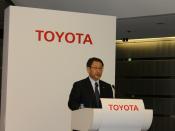When we talk about Japan we think of one of the most affluent technological and industrial leaders in the world. We think of high-end electronics and highly educated and expertly trained professionals. Throughout the last few years, financial eyes have been on the Japanese stock market as it slowly makes its economic recovery. ÃÂJapanÃÂs stock market has been locked in a bear market since 1989,ÃÂ (Waggoner, 2004) hitting its peak in January 1990. In 2003, the Tankan survey found that ÃÂbusiness confidence had weakenedÃÂ with much of the blame on rising oil prices and a stronger yen. Despite all of this, their stocks have risen 12.4% in 2004 while unemployment fell. Financial analysts also reported that TokyoÃÂs real estate prices were rising.
BBC News reports ÃÂJapan owes its change in fortune to booming export demand from China.ÃÂ Toyota, who gets most of its sales from the United States have been seeing higher revenues.
To follow through with this positive swing, in March of 2004 Moody raised Japans debt rating to AA+.
In 1990 the Japanese yen was valued at 160 yen to the US dollar. By 1995 it peaked at 80 yen to the US dollar and is currently at 111 yen. In July of 2005, Forbes announced that the Japan Stock market was trading at a 17-year high. Investors speculate that the stock market will ÃÂcontinue to outperform the US and most European marketsÃÂ and the economy will expand moderately. (Hutchinson, 2004)The Japan Index Fund (NYSE:EWJ) can easily be found on Yahoo! Finance. The fundÃÂs, which is listed number 13 on YahooÃÂs! top 20 list of funds to invest in, top holdings include popular names such as Toyota Motor Corporation, Canon, Honda Motor Company and Sony Corporation. It has done fairly well since its inception in early 1996 until 2002-2003 when it fell in momentum with the rest of the stock market. It has since been gaining ground and fighting its way back to where it once stood.
Historical prices show that the fund is slowly but surely gaining value and its beta remains moderate with its category. This fund holds no front load or back load fees and no minimum investment. This seems to be a pretty good investment for those who are looking for long-term turnovers. Investors are standing by to see if the affects of the U.S. hurricanes will put any pressure on the markets. High oil prices are predicted to crimp consumer spending which will hurt corporate profits.
Works CitedHutchinson, Martin. ÃÂJapan: Recovery at Last.ÃÂ www.fool.comMay 25, 2004.
ÃÂJapan economy ÃÂgetting strongerÃÂ.ÃÂ http://news.bbc.co.uk May28, 2004.
ÃÂJapanese stock market roars ahead.ÃÂ http://news.bbc.co.ukJune 7, 2004.
ÃÂJapanese Stocks Rise; Dollar Higher.ÃÂ www.in-forum.comSeptember 21, 2005.
ÃÂNikkei tops 13,000 for first time since 2001.ÃÂ www.tehrantimes.
com. September 21, 2005.
ÃÂRetail investorsÃÂ share of Japan stock market trading at 17-yearhigh-report. www.forbes.com July 1, 2005.
ÃÂStock market eyes Japan recovery.ÃÂ http://news.bbc.co.ukDecember 30, 2004.
Waggoner, John. ÃÂJapanese funds are as hot as wasabi.ÃÂ www.
usatoday.com. July 7,2004.
Yahoo! Finance.com





